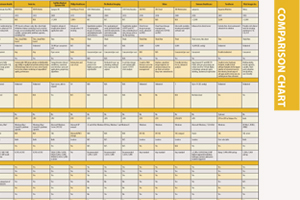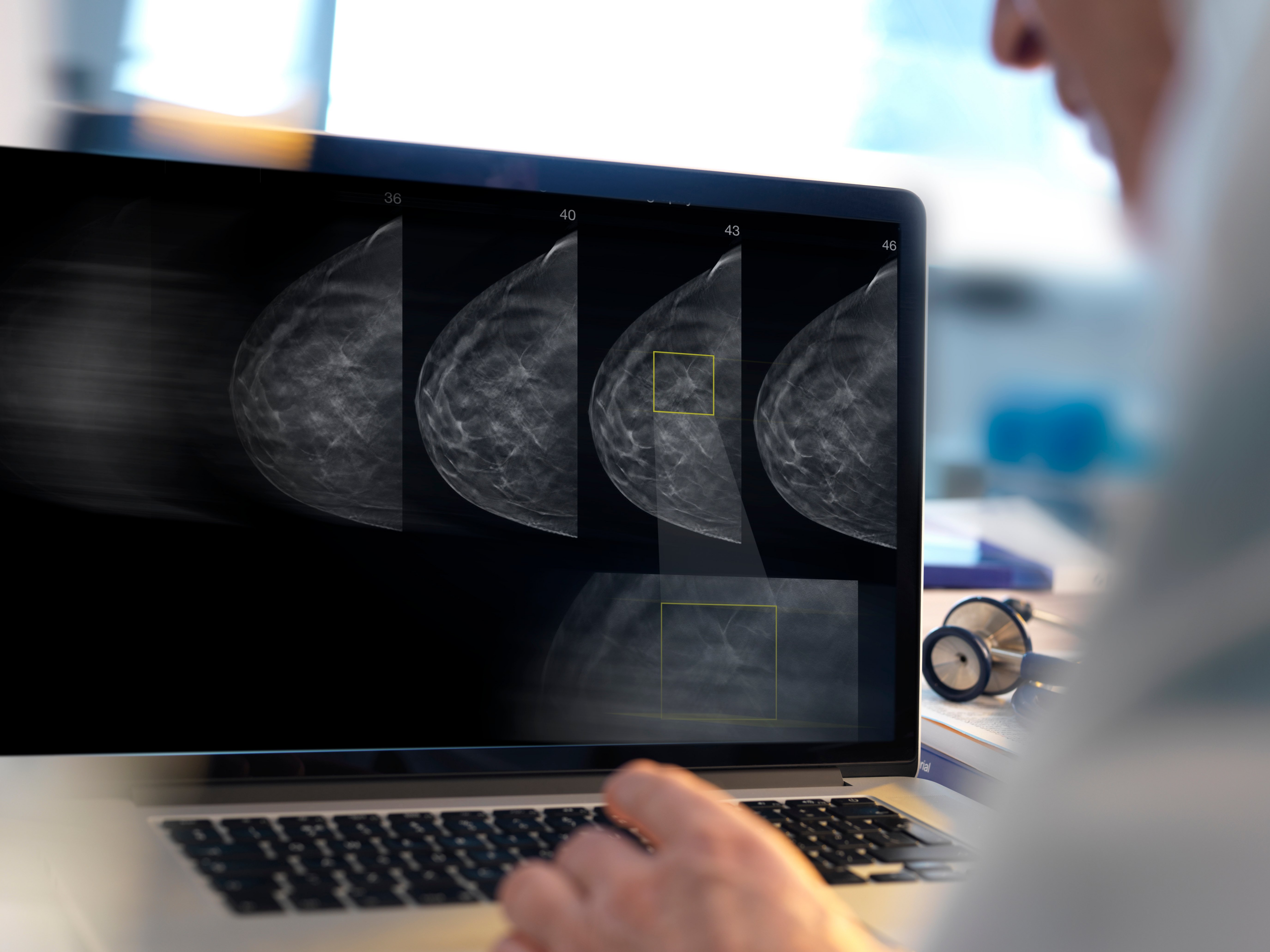New advancements have the potential to improve early breast cancer detection, but the industry must first overcome the barriers limiting patient access to screening
Getty Images
Mammography is one of the great triumphs of innovation in breast cancer care, as it is the only screening technology proven to decrease the breast cancer mortality rate. It is the essential tool in a radiologist’s toolkit for breast cancer screening and detection. Despite that success, it has known limitations the industry has been working to overcome since the technology first debuted with the goal of increasing early invasive cancer detection while reducing false positives.
Arguably the most significant advancement in mammography screening since its inception has been the advent of digital breast tomosynthesis (DBT). In the 10 years since the U.S. FDA approved the first DBT system, using this technology radiologists have overcome many of the shortcomings of traditional 2-D mammography. Since then, DBT has been widely adopted in the U.S. as the standard
of care for breast cancer screening.
The most notable outcomes of DBT adoption have been significant improvements in detection and reductions in recall rates. Take for example the 3Dimensions mammography system from Hologic, which has been shown to detect 20 to 65% more invasive cancers than a 2-D mammogram alone1 and has also been FDA approved as superior to 2-D mammography for women with dense breasts.1, 2 Furthermore, the DBT system also reduces false positive rates compared to full field digital mammography,3 which has the potential to not only spare women the emotional toll of unnecessary callbacks but also reduce the economic impact on the healthcare system. 
A malignancy easily missed with conventional 2-D mammography was clearly seen with Hologic 3-D Mammography.
It is expected that the future of mammography will build upon the foundation established by DBT, setting the stage for innovation and improved patient care. One of the most exciting areas of advancement is artificial intelligence (AI), particularly for improving cancer detection and workflow.
These deep learning-enabled tools currently help radiologists achieve faster turnarounds and potentially deliver more accurate results by prioritizing cases, highlighting areas of concern in real time, and identifying calcifications, architectural distortions and masses. Notably, AI has shown promise in reducing the amount of time spent on interpretation, which can reduce reader fatigue, alleviate the impact from global radiologist shortages, and counteract the increased volume of reading stemming from DBT image sets.
However, the industry must be careful to maintain this momentum by ensuring the integrity and quality of the AI systems it relies on. When exploring new AI tools, radiologists should not only consider how it integrates into their existing systems, but also if the manufacturer will continue to offer integration with system updates. This has been a lingering challenge, as AI algorithms must be continually updated in tandem with improvements made to the imaging technology itself, otherwise the AI technology becomes obsolete.
Additionally, radiologists should analyze and question the robustness of the database used to train their AI tools. Without an extensive database to train AI, the results will never meet expectations. In particular, these databases must include meaningful representation from a diverse body of patients across disease state, gender, age, race and ethnicity, region and beyond. This is critical to ensure successful application in the real world and provide the best diagnostic capabilities.
While many health centers are already enjoying detection and workflow benefits from their AI integrations, the full breadth and depth of the technology’s potential is yet to be realized. In many ways, AI is poised to bring about the next era of groundbreaking advancements in mammography.
Looking ahead, one area of opportunity for AI is correlating images across modalities, thus allowing radiologists to achieve a more accurate picture of a patient’s disease using data from DBT and diagnostic ultrasound imaging. Another may be helping to inform risk assessment and care pathways through analysis of image databases and outcomes.
AI’s potential benefit also extends beyond patient care, as it could be leveraged to optimize the mammography systems themselves. For example, AI could be used to assess or create predictive analytics for system reliability, allowing for proactive maintenance that may prevent unexpected or unnecessary downtime, which ultimately benefits facilities’ efficiency and their bottom line. 
Developed using Lunit’s deep learning technology, Lunit Insight MMG will accurately analyze mammography images to detect lesions that could indicate breast cancer and provides location information for any detected lesions in the form of outlines and heatmaps.
Through ongoing efforts to improve cancer detection, contrast-enhanced imaging has been introduced to diagnostic mammography to augment morphologic data with physiological information to better understand if a lesion of concern is growing. Early indications show it could provide better visibility of cancer when used in diagnostic mammography, especially important for women at high risk or who have dense breasts. Notably, the anticipated benefits of widespread adoption of contrast-enhanced imaging extend beyond improved cancer detection. As we look to the future, the real value-add the industry expects this technology advancement will offer is expanding patient access and increasing facility efficiency.
Additional research is required, however preliminary insights indicate contrast-enhanced mammography has the potential to serve as an alternative for magnetic resonance imaging (MRI) when imaging high-risk patients. This is key for addressing access, as MRI systems are often inaccessible for patients in rural communities or those who suffer from prohibitive claustrophobia. Furthermore, the technology lends itself to enhanced clinical efficiency when compared to MRI procedures and could thus aid imaging centers seeking ways to be more efficient and process higher volumes of patients.
As the industry continues to build a repository of clinical data surrounding the efficacy and value of contrast-enhanced mammography, it is expected that there will eventually be a clearly defined care pathway in which high risk patients who need supplemental imaging will be recommended to receive contrast-enhanced mammography as the standard of care.
Together, these advancements have the potential to be monumental for patients and providers. However, for these technologies to have an impact, the industry also needs to overcome barriers limiting patient access to breast cancer screening. These barriers are plentiful and wide-ranging, including anxiety and fear of pain related to the procedure itself, low income and lack of health insurance, distrust in the healthcare system, limited access to transportation, confusing and inconsistent screening guidelines, and more. Identifying ways to address these challenges will be a priority for the future of mammography, and technology will inevitably play a role in these solutions.
A recent success in this space has been using mammography advancements to improve patient comfort. For some patients, fear of pain and discomfort associated with mammography screening can impact compliance with annual screening protocols. In fact, one survey found 49% of women reported fear of anxiety and pain as the reason they never had a mammogram.4 Therefore, it is expected that innovations in DBT gantries will bring additional features that meaningfully improve comfort. An example of which is the recent introduction of curved breast paddles, which have been clinically proven to deliver a more comfortable mammogram compared to standard compression.5
Just as mammography stands as one of the greatest achievements in breast cancer diagnosis and treatment, these advancements are poised to become the next essential tools for radiologists in the fight against breast cancer. Continued innovation is critical to realizing our ultimate goal of accurately diagnosing and saving every patient impacted by this disease.
Jennifer Meade is the President of Hologic’s Breast and Skeletal Health Division and has been part of the company since 2006. In her role, she is committed to continuing to drive innovation across the breast care continuum and investing in the company’s people to ultimately drive improved outcomes for patients around the globe.
1. Results from Friedewald, SM, et al. “Breast cancer screening using tomosynthesis in combination with digital mammography.” JAMA 311.24 (2014): 2499-2507; a multi-site (13), non-randomized, historical control study of 454,000 screening mammograms investigating the initial impact the introduction of the Hologic Selenia Dimensions on screening outcomes. Individual results may vary. The study found an average 41% increase and that 1.2 (95% CI: 0.8-1.6) additional invasive breast cancers per 1,000 screening exams were found in women receiving combined 2D FFDM and 3D mammograms acquired with the Hologic 3D Mammography System versus women receiving 2D FFDM mammograms only.
2. FDA submissions P080003, P080003/S001, P080003/S004, P080003/S005
3. Destounis, S. V., Morgan, R., & Arieno, A. (2015). Screening for dense breasts: Digital Breast Tomosynthesis. American Journal of Roentgenology, 204(2), 261–264. https://doi.org/10.2214/ajr.14.13554
4. Kadence International, Ten Thousand Quantitative Findings Research Study (5107), April 2017.
5. Smith, A. Improving Patient Comfort in Mammography. Hologic WP-00119 Rev 003 (2017).
Digital Breast Tomosynthesis Spot Compression Clarifies Ambiguous Findings
AI DBT Impact on Mammography Post-breast Therapy
ImageCare Centers Unveils PINK Better Mammo Service Featuring Profound AI
Radiologist Fatigue, Experience Affect Breast Imaging Call Backs
Fewer Breast Cancer Cases Between Screening Rounds with 3-D Mammography
March 28, 2022 — An artificial intelligence (AI) tool can accurately and consistently classify breast density on …
March 28, 2022 — The appearance of ovarian lesions on ultrasound is an effective predictor of cancer risk that can help …
March 25, 2022 — SBI presents the Symposium Collection Series, a curation of lectures from the Society’s recent annual …
March 25, 2022 — Royal Philips, a global leader in health technology, and NHS National Services Scotland, a non …
March 21, 2022 — Oklahoma’s House passes breast cancer screening legislation. Alabama introduces a bill to permit …
March 21, 2022 — Women’s Excellence is pleased to announce that the Women’s Radiology Center has successfully met …
March 10, 2022 — Hologic and the WTA kicked off a multi-year partnership this week with their first onsite activities at …
March 7, 2022 — AdvaMed is saddened to share that a beloved member of the AdvaMed family, Wendy Siminski, Senior Vice …
March 4, 2022 — The WTA and Hologic today jointly announced a landmark partnership introducing Hologic as the global …
The COVID-19 pandemic had a huge impact on the radiology community. Hospitals, doctors’ offices and clinics found …
See All Webinars
See All Videos
See All Blogs
See All Comparison Charts
Author Profile
Latest entries
 राशीफल2024.04.24आज का वृषभ राशि का राशिफल 24 अप्रैल 2024: लाभ दिलाने वाला रहेगा आज का दिन – NBT नवभारत टाइम्स (Navbharat Times)
राशीफल2024.04.24आज का वृषभ राशि का राशिफल 24 अप्रैल 2024: लाभ दिलाने वाला रहेगा आज का दिन – NBT नवभारत टाइम्स (Navbharat Times) लाइफस्टाइल2024.04.24वेट लॉस करने से लेकर फर्टिलिटी बढ़ाने तक में मददगार है ग्रीन टी, जानिए इसके बारे में कुछ जरूरी बातें – Hindustan
लाइफस्टाइल2024.04.24वेट लॉस करने से लेकर फर्टिलिटी बढ़ाने तक में मददगार है ग्रीन टी, जानिए इसके बारे में कुछ जरूरी बातें – Hindustan धर्म2024.04.24कंतारा की तरह ही इन 9 फिल्मों में आपको मिलेगी भारतीय लोक कथाओं की झलक – HerZindagi
धर्म2024.04.24कंतारा की तरह ही इन 9 फिल्मों में आपको मिलेगी भारतीय लोक कथाओं की झलक – HerZindagi राशीफल2024.04.23राशिफल : आज चमकेगा इन 5 राशियों का भाग्य, मनाएंगे जश्न – Hindustan
राशीफल2024.04.23राशिफल : आज चमकेगा इन 5 राशियों का भाग्य, मनाएंगे जश्न – Hindustan











